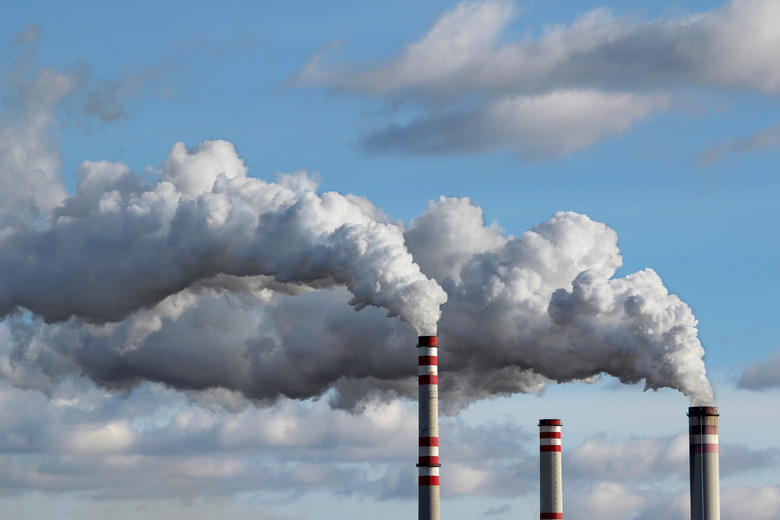How To Cure Smoke Pollution From Factories
Smog from factories represents an existential threat to both the environment and human health. Over the years, different governments around the world have mandated actions to reduce the level of toxic emissions from industrial processes, such as reducing the amount of harmful chemicals used in these processes, and utilizing technologies to capture them before the chemicals enter Earth's atmosphere. In the United States, the Environmental Protection Agency can mandate rules for chemical emissions from the country's numerous factories, though other countries have varying degrees of regulation on these emissions. China, for instance, remains one of the largest producers of CO2 in the world. Since 1990. the EPA has put regulations on more than 174 industries, including steel mills, aerospace manufacturers and chemical plants.
TL;DR (Too Long; Didn't Read)
To varying degrees across countries, regulations exist that limit the amount of harmful chemicals released in industrial processes. Two tactics in reducing these emissions include using cleaner, more environmentally friendly materials and installing carbon sequestering technologies that remove chemicals from the smoke stacks of a factory.
What Is Smoke Pollution?
What Is Smoke Pollution?
Different industries across the world use different materials and chemicals to make their product. For example, the energy sector in the United States uses coal, a means of generating electricity that is particularly damaging to humans and the environment. In 2014, the United States' coal power industry released 41.2 tons of lead, 9,332 pounds of cadmium, 576,185 tons of carbon monoxide and 77,108 pounds of arsenic into the air. This non-exhaustive list comes with numerous harmful side effects for humans, including cancer, heart disease and bronchitis. The list also contains sulphur dioxide and mercury, which can cause acid rain and make fish poisonous to humans, respectively. Many of these chemicals also act as greenhouse gases, which contribute to human-made climate change.
Industries Going Green
Industries Going Green
Part of government efforts to reduce industrial air pollution involves encouraging or enforcing renewable and clean sources of energy rather than coal and fossil fuels. Around 85 percent of the United States' energy comes from fossil fuels, rather than relatively clean and renewable resources like solar or wind energy. Other industries, like the creation of chemicals in factories, can release greenhouse gases similar to those from the energy sector, though with a different plethora of dangerous chemicals released, such as formaldehyde. While new technologies allow these plants to use different, potentially less-harmful materials, industries may find it challenging to use environmentally friendly resources considering it is, largely, easier to use their harmful counterparts that have a long history of industrial use. Other companies, as such, could out-perform environmentally conscious businesses economically.
Chemical Sequestration Programs
Chemical Sequestration Programs
Newer technologies, sometimes called "scrubbers," filter carbon out of the gases released during industrial processes. Companies that follow this practice, then, take the sequestered greenhouse gases and place them in areas where their harm is diminished, like deep underground. Some scientists advocate for applying this tactic to other chemicals released during manufacturing. That said, this strategy is not a cheap one, and it can increase the cost of numerous consumer goods and services like energy.
References
- The Free Dictionary: Air Pollution
- United States Environmental Protection Agency: The Plain English Guide to the Clean Air Act
- United States Environmental Protection Agency: Reducing Emissions of Hazardous Air Pollutants
- Massachusetts Institute of Technology: Air Pollution Solutions
- Union of Concerned Scientists: Coal and Air Pollution
- United States Environmental Protection Agency: Global Greenhouse Gas Emissions Data
- Encyclopaedia Britannica: Carbon Sequestration
- TNO: Sustainable Chemical Industry: Reducing Cost and Time to Market
Cite This Article
MLA
Johnson, Doug. "How To Cure Smoke Pollution From Factories" sciencing.com, https://www.sciencing.com/cure-smoke-pollution-factories-23979/. 11 April 2018.
APA
Johnson, Doug. (2018, April 11). How To Cure Smoke Pollution From Factories. sciencing.com. Retrieved from https://www.sciencing.com/cure-smoke-pollution-factories-23979/
Chicago
Johnson, Doug. How To Cure Smoke Pollution From Factories last modified August 30, 2022. https://www.sciencing.com/cure-smoke-pollution-factories-23979/
